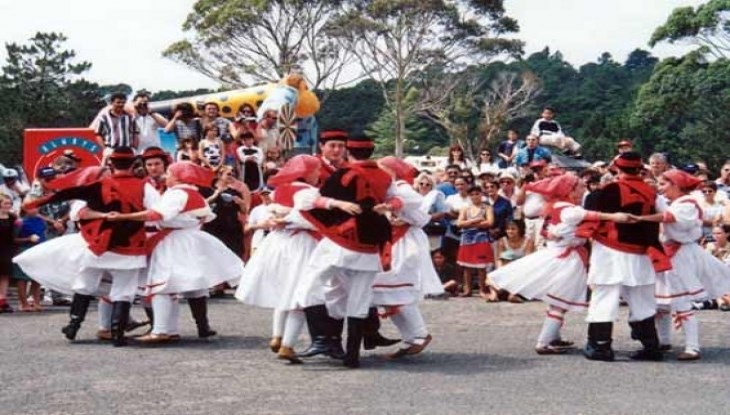Croatian Diaspora in New Zealand
Number of Croats in New Zealand and their immigration
According to the information at the webpage (https://www.mfat.govt.nz/en/countries-and-regions/europe/croatia) of the Ministry of Foreign Affairs and Trade of New Zealand there are 100,000 Croats and their descendants living in New Zealand. Of that number, more than 2,5000 have Croatian citizenship. There are only few of them who can speak Croatian.
Croatian immigrants who came to New Zealand in the second half of the 19th century were among the first engaged in kauri-gum digging which was exploited in New Zealand until the 30s of the 20th century. It was a major source of income for most immigrants.
Fishing was another sector in which Croatian immigrants worked. In 1934 they had 16 fishing boats and even today many work in the fishing industry. They have also been successful as winegrowers and fruit growers. Henderson near Auckland is a well-known centre of Croatian winegrowers.
Today, the majority of Croats are located on Northland and in and around Auckland. There are Croats who live around Kaita (descendants of the first immigrants- kauri-gum diggers) in Hamilton, Whangarei, Wellington and Christchurch as well.
It is considered that Croats represent the second largest immigration group in New Zealand after Irish. About 98% of them came from Makarska and surrounding area (Podgora, Drvenik, Živogošće), then from the islands of Korčula, Hvar and Brač. The earliest Croatian settlers were almost exclusively from Dalmatia. After WWII immigrants came from other parts as well due to economic reasons. Almost half of them did well, and rather large number of Croats have an important role in the economic life of New Zealand.
At the turn of the century until 1930s and even later the ratio between men and women was 96% men to 4% women. So, our immigrants literally “ordered” girls from the homeland who arrived to New Zealand “at the invitation” and the concept of marriage through authorised signatory was widely spread. The ratio significantly changed only after WWII.
First immigrants mostly came due to economy reasons. Men were highly represented; there were only a small number of women immigrants.
For the last 10-15 years more than 10 thousand of highly educated Croats immigrated to NZ. Most of them stayed in Auckland, smaller number left for Wellington, Palmerston, Borth and New Plymouth. They were mostly IT specialists, professors, doctors, dentists, solicitors, economists etc. Most of them are from big towns in Croatia: Zagreb, Split, Osijek, Vukovar, Rijeka, Šibenik, Pula. The average age when they immigrated was 26-45 years of age, mainly married couples with one or two children. Some of them did well (IT specialists) while a substantial number went to Australia and some returned to Croatia.
Status of Croats in New Zealand
Most Croats in New Zealand are New Zealand citizens, i.e. have the same rights and responsibilities as other New Zealenders.. New Zealand does not acknowledge term “temporary workers” or “national minorities” as European countries do. Therefore, Croats have no special political status but rather enjoy all rights as New Zealand citizens.
Immigrants can apply for citizenship after living in New Zealand for three years. Once they acquire citizenship they can enter Australia without Visa. So, for many Croatians New Zealand was a stepping stone on their way to Australia.
Croatian Associations and Catholic Missions
The main promoters of Croatian culture and identity, besides Catholic Missions, are Croatian associations, as is the case in most countries where Croatian immigrants live. In the last ten years the membership and activities of all associations and organizations have decreased. Well known associations in New Zealand are:
- Croatian Cultural Society in Auckland ( part of which is Croatian Women league)
- Dalmatian Cultural Society in Auckland
- Croatian Cultural Society in Hamilton
- Croatian Cultural Society in Wellington
- Dalmatian Cultural Society in Kaitai
There are two klape (multipart singing originated in Dalmatia) in Auckland: klapa “Dalmati“ and klapa “Dalmatina“. Also, there is a local branch of Croatian Democratic Society. More than 100 years Croatian Catholic Mission, located in the western suburb of Auckland, has been active.
Croatian classes and courses of the Croatian language
Croatian Supplementary school in Auckland, New Zealand was established in 1997 by Croatian Ministry of Science and Education. Until 2003 the classes were held at two locations, at St. Joseph Catholic School in central Auckland and in the premises of the Croatian Cultural Society in west Auckland. During 2006 Croatian Cultural Society assigned their own teachers to teach Croatian, and the Croatian Ministry of Science and Education ceased to appoint and send teachers from Croatia, which led to closing of Croatian Supplementary school within the competence of the Ministry.
At the same time, the courses of the Croatian Language have been organized for years at the Dalmatian Cultural Society.
Publishing and Media
There are no Croatian publishing activities in New Zealand, or Croatian newspaper for that matter. Croatian radio program is aired once a week at the radio station in Auckland (Croatian radio planet FM) and Community radio in Hamilton (1206 AM). It lasts for an hour.



